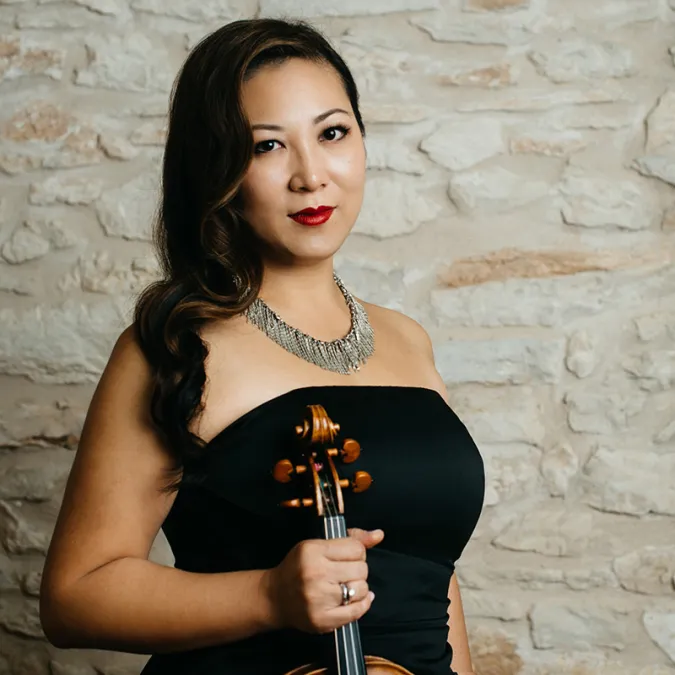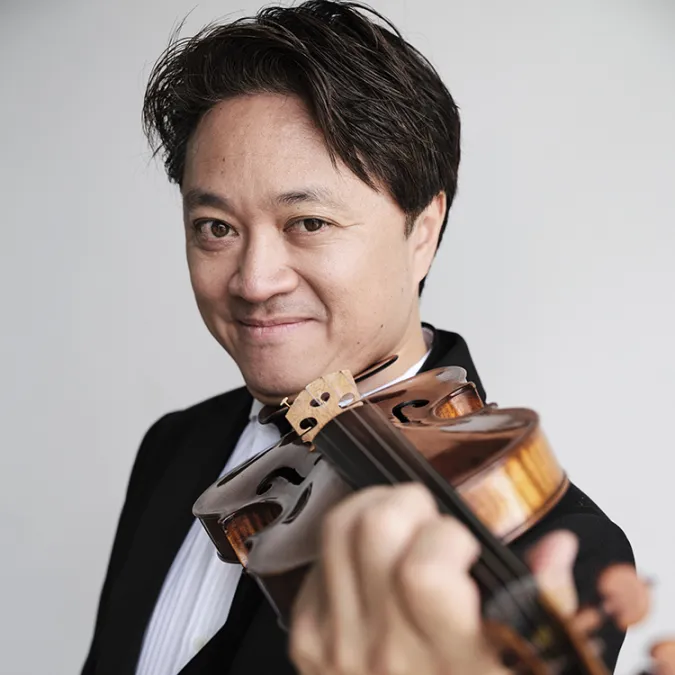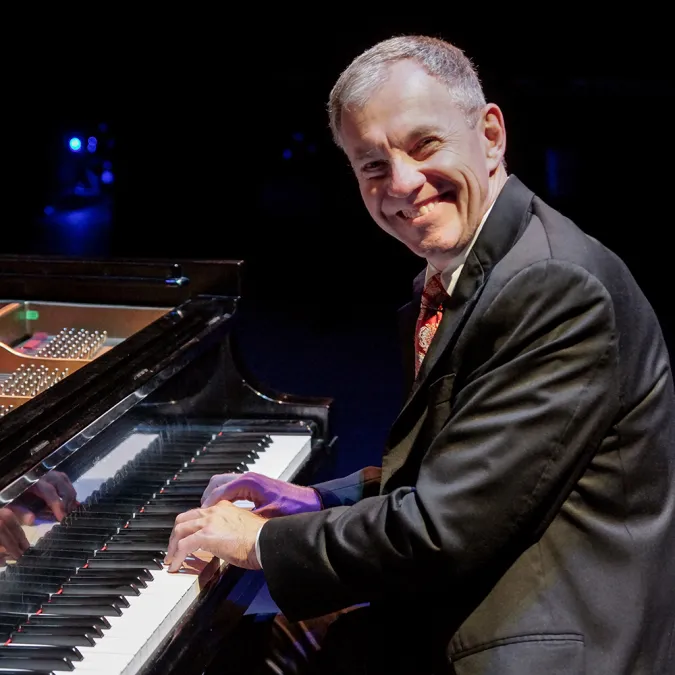
Daniel Ching, viola
Bion Tsang, cello
Anton Nel, piano
Featured Student Guests
Chloe Yofan, violin
Mei Liu, violin
Jason Lan, viola
Thomas Gougeon, viola
Katsuaki Arakawa, cello
Yeyoung Yoo, cello
This program will last approximately 90 minutes with one intermission.
Program
Johannes Brahms
String Sextet No. 1
in B-Flat Major, Op. 18
Allegro ma non troppo
Andante, ma moderato
Scherzo: Allegro molto
Rondo: Poco allegretto e grazioso
Sandy Yamamoto, violin I
Chloe Yofan, violin II
Jason Lan, viola I
Daniel Ching, viola II
Bion Tsang, cello I
Katsuaki Arakawa, cello II
intermission
César Franck
Piano Quintet in F Minor
Molto moderato quasi lento – Allegro
Lento con molto sentiment
Allegro non troppo ma con fuoco
Anton Nel, piano
Sandy Yamamoto, violin I
Mei Liu, violin II
Thomas Gougeon, viola
Yeyoung Yoo, cello
About the Program
Program notes by Mark Bilyeu
Johannes Brahms
String Sextet No. 1
in B-flat Major, Op. 18
Born May 7, 1833, Hamburg, Germany
Died April 3, 1897, Vienna, Austria
Composed 1860
Premiered October 20, 1860, Hanover, Germany
Duration 35 minutes
On February 23, 1861, the Hamburger Nachrichten newspaper reviewed a concert which featured Johannes Brahms’ newest chamber work: his string sextext, Op. 18. The reviewer called it “one of the most beautiful works written by the young composer,” who had, until this point, only written primarily for solo piano or Lieder for piano and voice (the exception to this is his Piano Trio in B-Major, which he completed in 1854). It seems evident that Brahms actively avoided comparisons to Beethoven, and so when seeking to enter this new arena of chamber music, he side-stepped the string quartet, and chose instead the more unusual sextet. The first movement is emblematic of Brahms, even at the age of 21. Although the movement is in a waltz time of three beats per bar, the cello melody Brahms spins requires four, thus off-setting downbeats. This compositional sleight-of-hand might put the listener on-edge, but with Brahms’ rhythmic subtlety, one can’t help but sit back in one’s chair, comforted by the cushion of sound the additional low strings are providing. The second movement opens in dark hues, Brahms asking the viola to introduce a melancholy melody reminiscent of his trips through Hungary. Five variations of the melody follow, with the final variations offering a bit of cautious hope. The third movement is what caught the attention of Julius Otto Grimm, composer and confidant. After receiving the first three movements before publication, he wrote to Brahms, saying “I was delighted by the movements of your sextet. The Scherzo is fresh and exerts an irresistible pull on me.” The final movement dabbles in Classical structures, but presents itself more a hybrid than formula. Brahms takes the six strings and divides them into two trios, as the high strings and low strings barrel towards the end, alternating delicate textures with waves of sonority, until a declamatory call-and-response carries them – and the listener – to the thrilling conclusion.
César Franck
Piano Quintet in F-Minor
Born December 10, 1822, Liège, United Kingdom of the Netherlands
Died November 8, 1890, Paris, France
Composed 1879
Premiered January 17, 1880 by Camille Saint-Saëns (piano)
Duration 37 minutes
César Franck was a well-established composer in 1879, with an appointment at the Paris Conservatory and a devoted circle of students including Augusta Holmès (1847–1903), who published her compositions under the pseudonym Hermann Zenta. Franck was inspired by his students to explore new chromatic sounds, which resulted in mixed reactions from audiences. He dedicated his piano quintet to Camille Saint-Saëns (1835–1921), who is said to have been so disgusted with the piece that he stormed off stage and left the manuscript, complete with its dedication to him, on the piano after the first performance. It was rumored that Franck was attracted to Holmès, who Saint-Saëns had previously proposed to, and the possibility that Franck intended this piece as an amorous tribute to her apparently offended Saint-Saëns. Franck’s wife Eugénie-Félicité-Caroline Saillot (1824–1918) loudly denounced the quintet, and even Franz Liszt (1811–1886) was purportedly shocked by its passionate intensity. Although Franck adhered to classical forms — two movements in sonata form surround a slow ternary movement — the harmonic and rhythmic contrasts are constantly unsettling. Thematic continuity holds the three movements together while distant keys are explored, pairing tumult with careful construction for a result that is deeply moving.
About the Artists
Sandy Yamamoto

Violinist Sandy Yamamoto has dazzled audiences in concert performances around the globe for the past three decades as a soloist and as a member of the Miró Quartet. With the Miró Quartet, she performed on the major concert stages of the world, regularly concertizing in North America, South America, Europe and Asia. As a member of the Quartet, she was a recipient of the Naumburg Chamber Music and Cleveland Quartet Awards, won First Prize at the Banff International String Quartet Competition and was one of the first chamber musicians to be awarded an Avery Fisher Career Grant. Since leaving the Quartet in May 2011, she has been appointed Associate Professor of Practice in Violin Performance at the Butler School of Music and was the recipient of the Butler School of Music Teaching Excellence Award. For the 2024-25 season, she is Co-Concertmaster of the San Antonio Philharmonic under the artistic leadership of Jeffrey Kahane. Most recently, she has accepted a position as the new Artistic Director of the Austin Chamber Music Center.
Daniel Ching

Daniel Ching, a founding member of the Miró Quartet, began his violin studies at the age of 3 under tutelage of his father. At age 5, he entered the San Francisco Conservatory Preparatory Division on a full twelve-year scholarship, where he studied violin with Serban Rusu and Zaven Melikian, and chamber music with Susan Bates. At the age of 10, Daniel was first introduced to string quartets.A graduate of the Oberlin Conservatory of Music, Daniel studied violin with Kathleen Winkler, Roland and Almita Vamos, and conducting with Robert Spano and Peter Jaffe. He completed his Masters degree at the Cleveland Institute of Music, where he studied with former Cleveland Quartet violinist Donald Weilerstein. He also studied recording engineering and production with Thomas Knab of Telarc, and subsequently engineered the Miró Quartet’s first promotional disc. Daniel is on faculty at the Sarah and Ernest Butler School of Music at the University of Texas at Austin, where he teaches private violin students and coaches chamber music. He concurrently maintains an active international touring schedule as a member of the Miró Quartet.
Bion Tsang

Winner of an Avery Fisher Career Grant and the Bronze Medal in the International Tchaikovsky Competition, cellist Bion Tsang has appeared with the New York, Mexico City, Moscow, Busan and Hong Kong Philharmonic Orchestras, the Atlanta, Pacific, American and National Symphony Orchestras, the Saint Paul and Stuttgart Chamber Orchestras, the Hollywood Bowl Orchestra and the Taiwan National Orchestra. As a chamber musician, Mr. Tsang has collaborated with violinists Pamela Frank, Jaime Laredo, Cho-Liang Lin and Kyoko Takezawa, violist Michael Tree, cellist Yo-Yo Ma, bassist Gary Karr and pianist Leon Fleisher. He has been a frequent guest of the Chamber Music Societies of Boston, Brooklyn, Fort Worth and Seattle, Chamber Music International (Dallas), Da Camera of Houston, and performed at the festivals of Marlboro, Manchester, Portland and Tucson, the Bard Festival, Bravo! Colorado, and the Laurel Festival of the Arts, where he served as Artistic Director for ten years. Mr. Tsang received his BA from Harvard University and his MMA from Yale University, where he studied with Aldo Parisot. His other cello teachers included Ardyth Alton, Luis Garcia-Renart, William Pleeth, Channing Robbins and Leonard Rose. Mr. Tsang holds the Joe R. & Teresa Lozano Long Chair in Cello at UT.
Anton Nel

Winner of the 1987 Naumburg International Piano Competition at Carnegie Hall, Anton Nel continues to tour internationally as recitalist, concerto soloist, chamber musician and teacher. Highlights in the U.S. include performances with the Cleveland Orchestra, and the Chicago, San Francisco, Dallas, Seattle, and Detroit Symphonies as well as coast to coast recitals. Overseas he has appeared at the Wigmore Hall in London, the Concertgebouw in Amsterdam, Suntory Hall in Tokyo, and major concert halls in China, Korea and South Africa. He holds the Joe R. and Teresa Lozano Long Endowed Chair at the University of Texas at Austin where he heads the Division of Keyboard Studies. During the summers he is on the artist-faculties at the Aspen Music Festival and School, the Steans Institute at the Ravinia Festival, as well as the Orford Music Academy in Quebec. Mr. Nel also frequently performs as harpsichordist and fortepianist. His teachers include Adolph Hallis at the University of the Witwatersrand and Bela Siki and Frank Weinstock at the University of Cincinnati.
Upcoming Events
Symphony Orchestra
Sunday, September 29, 4:00 p.m.
Bates Recital Hall
Bion Tsang & Anton Nel
Wednesday, October 2, 7:30 p.m.
Bates Recital Hall
Triptych Trio
Wednesday, October 23, 7:30 p.m.
Bates Recital Hall
Miró Quartet
Monday, October 28, 7:30 p.m.
Bates Recital Hall
Yamazalde Trio
Thursday, October 31, 7:30 p.m.
Bates Recital Hall
Event Details
$10–20
All University of Texas at Austin students are allowed one free ticket as long as they are available. Student tickets must be picked up at the Box Office with valid student I.D. Seating is unassigned.
If you are a patron with ADA needs, please email tickets@mail.music.utexas.edu and we will reserve ADA seating for you.

